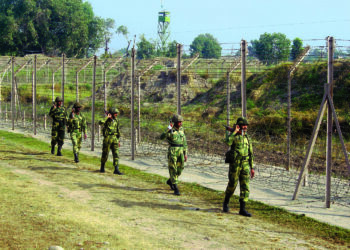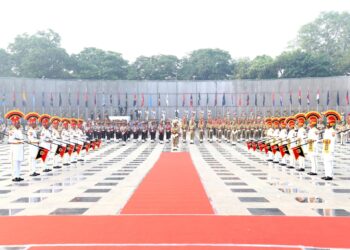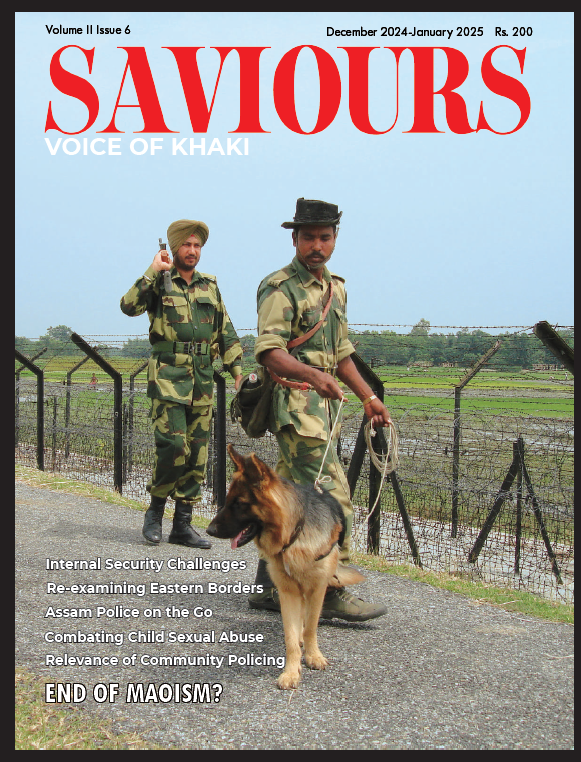Dr Sudhanshu Sarangi, former Director General of Police, Odisha, reviews The Enforcer, the biography of Prashant Kumar, former DGP of Uttar Pradesh.
Book Review:
Mitra, Anirudhya (2025)- “The Eneforcer- An IPS Officer’s War on Crime in India’s Badlands”, 317 pages, Juggernaut, New Delhi
‘The Enforcer’ is the authorised biography of the former Uttar Pradesh Police Chief Prashant Kumar. The author, investigative journalist Anirudhya Mitra, has sub-titled the book: An IPS Officer’s War on Crime in India’s Badlands.
Prashant Kumar is one of the most recognisable faces of the Indian Police in recent times. He superannuated in May 2025. One always finds a lack of balanced books on the Indian police. Police Officers absorb the rhetoric that has made them the favourite whipping boys of Indian society, rather than speak out. And when they decide to write, it is years or even decades after their retirement, by which time events described by them have gone stale. Mitra started the work on the book while Kumar was still the Police Chief of India’s largest state, and the book is out barely four months after his retirement. Topicality and contemporaneousness enhance the book’s attraction.
The author had to weave a story contending with two conflicting claims. In the first, Kumar becomes the face of a determined and systematic clampdown by the state of Uttar Pradesh on entrenched gangsters, leading to their decimation, with spin-offs such as people feeling safer, improved standards of the rule of law, and an ease of doing business that drew higher investment and rapid infrastructural growth. Organised crime syndicates that, in the past, networked with state institutions and exploited procedural gaps in the criminal justice system to thrive, saw the tables turned against them. Their empire collapsed when the very institutions and processes they had been manipulating came back to bite them hard. While committing crimes in brazen ways, they expected no witness to depose and the state to remain indifferent.

The opposing claim is that Kumar represents a policing strategy that relies on staged encounters with gangsters and bulldozer justice- shortcuts that go counter to the rule of law.
Mitra, with his experience as an investigative journalist, has given a fine-toothed comb treatment to the facts and evidence from both sides, concluding that the approach of the Uttar Pradesh Police, far from being encounter-oriented, was systematic and professional. Gangsters and criminal syndicates were carefully identified, kept under surveillance, and their support systems, such as patronage of corrupt police officers and financial bases, were degraded.
Criminal trials were carefully pursued by targeted monitoring. The list of gangsters convicted by the court included formidable figures such as Atiq Ahmed and Mukhtar Ansari. Yes, there were encounters, but that was only the most dramatic part and drew disproportionately more public attention. Kumar’s managerial and leadership role was exceptional in executing a well-crafted strategy.
The author quite skillfully joins two narratives- Kumar as a person and as a Cop. As a person, from childhood, Kumar was simple, straightforward, modest, and went about life matter-of-factly with sincerity and integrity. This no-frills personal life is much the same way Prashant Kumar pursued a career in policing throughout his career. The person and the Officer turn out to be the same. This fusion and continuity make the narrative believable and authentic. His early life foreshadows his policing strategies. The anecdotes join. This is not a biography full of imagery, dialogue, or narration. The protagonist is not seen struggling with conflicting emotions or ethical dilemmas; the narration is simple, focusing on documenting facts rather than philosophical reflection.
For Police Officers in many parts of India, the ‘Badlands’ would be an unfamiliar territory. Gangsters moving in convoys of forty vehicles, a minister being killed in the Police Station, and an ambush by criminals (not insurgents) killing nine police officers, is
unfathomable. No society should allow such a mess to develop in the first place. However, the policing strategy used by officers of the Uttar Pradesh Police would possibly work in any other society that decides to weed out multiple sources of illegitimate force that make a mockery of the rule of law. Nobel laureate Acemoglu and Robinson, after a careful review of the political economy of the world in the last five hundred years, argue that states that are firstly able to create centralised authority that can enforce the rule of law and secondly can create inclusive institutions become economically successful; others fail.
The policing strategy followed by the Uttar Pradesh Police under Kumar needs to be subjected to academic research rather than relying on anecdotal accounts. Any perception that a society can eliminate lawlessness even without basic police reform is problematic. The vacuum created by the decimation of established criminal syndicates can be filled either by new criminal syndicates or by overbearing policing and extractive institutions in the long run.
Prashant Kumar’s life is part of an aspirational journey of the Indian people; the destination in any modern democracy, however, should be the rule of law and inclusive institutions.
The book is a must-read for police officers, but it will also be valuable to anyone interested in public policy.









